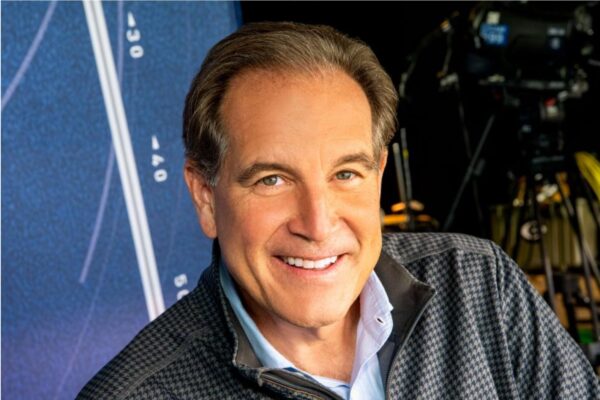By Frank Bonner II | @Frank_Bonner2
Sports Capital Journalism Program
INDIANAPOLIS — For the first time since the 1977-78 season, the NCAA men’s college basketball season tipped off on Tuesday without legendary college basketball writer Jim O’Connell at the Associated Press.
College basketball lost a significant piece of its culture when O’Connell, the former AP college basketball reporter and editor, died in July at the age of 64. O’Connell’s love for the game and standard of excellence in his reporting helped leave an everlasting mark on the sport. In honor of O’Connell’s legacy that includes 39 consecutive Final Four appearances, the Sports Capital Journalism program at IUPUI hosted the College Basketball Symposium at Bankers Life Fieldhouse on Tuesday.
Five panelists, all connected to O’Connell in some way, discussed issues and changes surrounding college basketball in the first season under the new legislation recommended by the Commission On College Basketball. Duke basketball coach Mike Krzyzewski, former Pacers Sports & Entertainment vice president Bill Benner, NCAA senior vice president Dan Gavitt, Time Magazine senior writer Sean Gregory and Associated Press sports reporter Michael Marot opened the discussion with memories and remarks about O’Connell, who friends and colleagues nearly always referred to as Oc.
“I considered it an honor to be his friend,” said Krzyzewski, who first met O’Connell over 40 years ago as coach at Army. “He was a true friend of the game. No one loved the game any more and he didn’t really want anything from the game. He felt that the game was always good to him. I like to refer to good people as being two-way people, they give and they take. Oc was a one-way person as far as the game. He only gave to the game.”
The five panelists discussed some of the key issues and concerns surrounding college athletes. Much of the discussion centered on amateurism and the issue of players potentially profiting off their name, image and likeness.
Krzyzewski, who has coached five national championship teams, said that this is the most unique time in the history of college basketball.
“We’re really taking an amazing look at amateur basketball in this country in an incredible way,” Krzyzewski said. “I just would love to make sure that all of the people who are involved, the NCAA, NBA and players’ union — those three entities especially — and USA Basketball would work together to formulate a plan moving forward that is in the best interest of the youngsters playing the game and the game itself.”
Krzyzewski expressed how important it is for the NCAA to become a more agile organization in terms of adapting its rules and policies to keep up with the changes. One pivot the NCAA has made is allowing players to obtain information from agents. Gavitt shared that players who have an interest in exploring professional opportunities are now cleared to formally engage with agents at the end of their season. There is a lot of complexity surrounding this new rule, Gavitt said.
“I think the thought around that was to provide the most opportunity and information to those prospects and their families making very difficult decisions about whether they’ll pursue their professional career or stay in college,” Gavitt said. “Some things need to be worked out in that area, but I do think, like in Coach K’s points, that’s an evaluation of what is going on around the game that the NCAA membership probably needed to embrace at this time.”
The recent G-League proposal to pay players coming directly out of high school adds another potential opportunity for athletes eager to earn money from their talents. There are logistical obstacles that will have to be worked out and discussed to make that possibility a reality. Gregory, who played college basketball at Princeton University in the 1990s, said he agrees with the Olympic model of allowing sponsorships for players. That looks to be the first logical step, he said.
“Once all the legalities get worked out,” Gregory said, “I think it’s fair and reasonable as a first step for giving more of the revenue perhaps to the players, for players to be able to get their third-party sponsorships and capitalize on their talents.”
Gavitt also mentioned that the commission felt the NCAA could liberalize some rules in regards to players profiting off their likeness once legal challenges are addressed. The need to include what Benner described as the elephants in the room were also addressed. Shoe and apparel companies such as Adidas, the focus of a recent high-profile trial, have become key players surrounding college basketball, and their involvement with the sport is something that can’t be ignored.
“We can bring the NCAA, the players union and the NBA all together, but they have to be a part of the conversation, too, with what we’ve just gone through with the trial,” Benner said of the shoe companies. “I don’t know how you can make meaningful moves forward without engaging the shoe companies to a significant degree.”
Marot alluded to the challenge of dealing with representatives of shoe companies that are not accountable under the NCAA governing umbrella.
“How do you bring the shoe companies into line with what the NCAA rules are, and how do you sanction them if they do something wrong?” Marot asked. “You don’t have subpoena power and that sort of thing, so I don’t know where you go with that.”
More questions and solutions could arise as college basketball continues to grow and evolve. No matter how the game changes, O’Connell’s stamp on the sport will remain for years to come.


